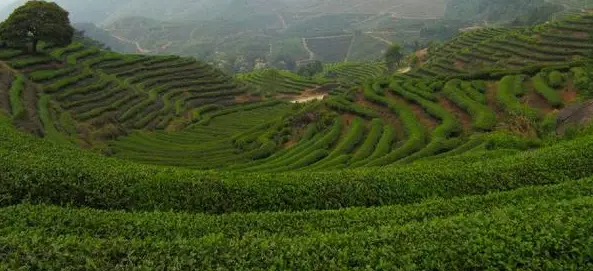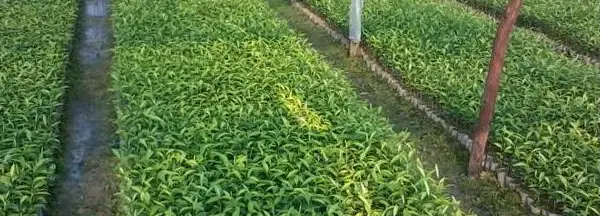Tea seedling cultivation technology
I. Tea seedling cultivation and planting technology
1. Land preparation and trenching
(1) When digging the planting trench, select a suitable soil with a pH value between 5.5 and 6.5. After plowing the garden, follow the specifications of double-row planting with a large row spacing of 120 cm, a small row spacing of 33 cm, and a cluster spacing of 30 cm. The planting trench width is 50 cm, the depth is 50 cm, and the bottom layer is loosened to 10 cm.
(2) When digging the trench, the subsoil and topsoil need to be piled separately. When backfilling, the topsoil should be buried in the bottom layer, and the subsoil should be placed on the surface layer. The row spacing of single-row planting is 110 cm, the cluster spacing is 33 cm, the planting trench width is 30 cm, the depth is 50 cm, and the bottom layer is loosened to 10 cm.
1. Land preparation and trenching
(1) When digging the planting trench, select a suitable soil with a pH value between 5.5 and 6.5. After plowing the garden, follow the specifications of double-row planting with a large row spacing of 120 cm, a small row spacing of 33 cm, and a cluster spacing of 30 cm. The planting trench width is 50 cm, the depth is 50 cm, and the bottom layer is loosened to 10 cm.
(2) When digging the trench, the subsoil and topsoil need to be piled separately. When backfilling, the topsoil should be buried in the bottom layer, and the subsoil should be placed on the surface layer. The row spacing of single-row planting is 110 cm, the cluster spacing is 33 cm, the planting trench width is 30 cm, the depth is 50 cm, and the bottom layer is loosened to 10 cm.

(3) After the planting trench is dug, apply base fertilizer in the trench. Apply 2000-3000 kg of weed or fence manure per mu, then cover with 20 cm of soil. After mixing with the soil, cover with another 10 cm of soil.
(4) Then apply the second layer of base fertilizer. Apply 200 kg of cake fertilizer per mu and 200 kg of tea tree fertilizer. Backfill with 20 cm of pure soil. Wait for a while until the loose soil sinks, leaving a 15-20 cm deep trench. Finally, plant the seeds.
(4) Then apply the second layer of base fertilizer. Apply 200 kg of cake fertilizer per mu and 200 kg of tea tree fertilizer. Backfill with 20 cm of pure soil. Wait for a while until the loose soil sinks, leaving a 15-20 cm deep trench. Finally, plant the seeds.

2. Planting tea seedlings
(1) Classify the tea seedlings by size and plant them separately. In the previously made trench, dig two shallow trenches with a depth of 10 cm. Then arrange the tea seedlings in a staggered manner in the planting trenches in the shape of a Chinese character "品". Plant two plants in each cluster. The tea seedlings need to be straightened and their roots straightened.
(2) Then cover the soil to the mud gate and tamp it gently. After the soil is thoroughly wetted, apply tea tree fertilizer or compound fertilizer 5 cm away from the roots of the tea seedlings. Then cover the soil to more than 5 cm above the mud gate. After the tea seedlings are planted, they should be trimmed 15 cm above the ground to reduce water evaporation from the leaves and increase the survival rate of the tea seedlings. After planting, grass should be laid between the small rows and around the tea seedlings to cover the ground. In dry weather, water should be applied frequently to keep the soil moist.
(1) Classify the tea seedlings by size and plant them separately. In the previously made trench, dig two shallow trenches with a depth of 10 cm. Then arrange the tea seedlings in a staggered manner in the planting trenches in the shape of a Chinese character "品". Plant two plants in each cluster. The tea seedlings need to be straightened and their roots straightened.
(2) Then cover the soil to the mud gate and tamp it gently. After the soil is thoroughly wetted, apply tea tree fertilizer or compound fertilizer 5 cm away from the roots of the tea seedlings. Then cover the soil to more than 5 cm above the mud gate. After the tea seedlings are planted, they should be trimmed 15 cm above the ground to reduce water evaporation from the leaves and increase the survival rate of the tea seedlings. After planting, grass should be laid between the small rows and around the tea seedlings to cover the ground. In dry weather, water should be applied frequently to keep the soil moist.

3. Transplanting
(1) If the weather is dry and water cannot be supplied during planting, the tea seedlings can be transplanted. The transplanting site should be a relatively cool, well-sited yellow soil plot near a water source. Then, dig shallow trenches with a row spacing of 15 cm. Arrange the tea seedlings in the trenches with a spacing of 3 cm and straighten the roots.
(2) Then cover the soil and tamp it gently. Water the soil until it is moist. Cover the soil to 5 cm above the mud gate. Spread grass between the rows to cover the soil surface. Cover the tea seedlings with some thatch or straw. After transplanting, water regularly to keep the planting soil moist. After rain, transplant and plant according to the technical requirements.
(1) If the weather is dry and water cannot be supplied during planting, the tea seedlings can be transplanted. The transplanting site should be a relatively cool, well-sited yellow soil plot near a water source. Then, dig shallow trenches with a row spacing of 15 cm. Arrange the tea seedlings in the trenches with a spacing of 3 cm and straighten the roots.
(2) Then cover the soil and tamp it gently. Water the soil until it is moist. Cover the soil to 5 cm above the mud gate. Spread grass between the rows to cover the soil surface. Cover the tea seedlings with some thatch or straw. After transplanting, water regularly to keep the planting soil moist. After rain, transplant and plant according to the technical requirements.